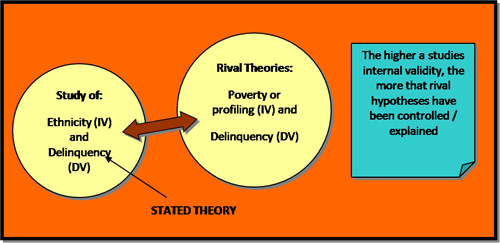Determining a Studies Internal Validity
Looking at a studies design helps to determine internal validity and causality in regards to the results of the study. It explains simply what you did to whom. The design of the study looks at the number of groups and measures, the independent and dependent variables, and whether the sample was randomly assigned.
The researcher can enhance internal validity by having a comparison group and a control group. Furthermore, randomly selecting and assigning participants can increase internal validity and reduce selection bias.
Ways to Enhance Internal Validity
- Comparison group or control group
- Randomly select and randomly assign participants (helps with selection bias)
Three Types of Design
- Pre-experimental
- Pilot study
- Usually one group, vulnerable to threats to internal validity
- Exploratory
- Quasi-experimental
- Does not involve random assignment
- Usually two groups
- Descriptive
- Experimental
- Cause and effect
- Two groups, random assignments, etc…
- Explanatory

Internal Validity
Internal Validity: Confidence that change in the dependent variable is caused by the independent variable and not something else.
Rival hypotheses: Another factor causing and or explaining the change in the dependent variable.
Threats to internal Validity
History: Outside even that coincides with the study and might be the real cause of your findings
Attrition or experimental mortality: In a longitudinal study, participants drop out
Maturation or passage of time: Sometimes clients get better or worse as time passes without intervention
Testing: Conditions of test that influence results (often pretests influences posttest results)
Instrumentation: There is a problem in the measure (either a bad measure or it’s administration was changed midway)
Selection bias: Individuals choose to participate (groups are unequal ≠ method of selecting participant’s impacts results)
Statistical regression: Extremely low scores at the pretest will likely improve slightly at the posttest (AKA regression towards the mean)
Ambiguity of causal influence: Can’t tell which is the Independent Variable (IV) and the Dependent Variable (DV) [“The chicken and the egg affect”]
Diffusion: Comparison and treatment group are getting very similar interventions